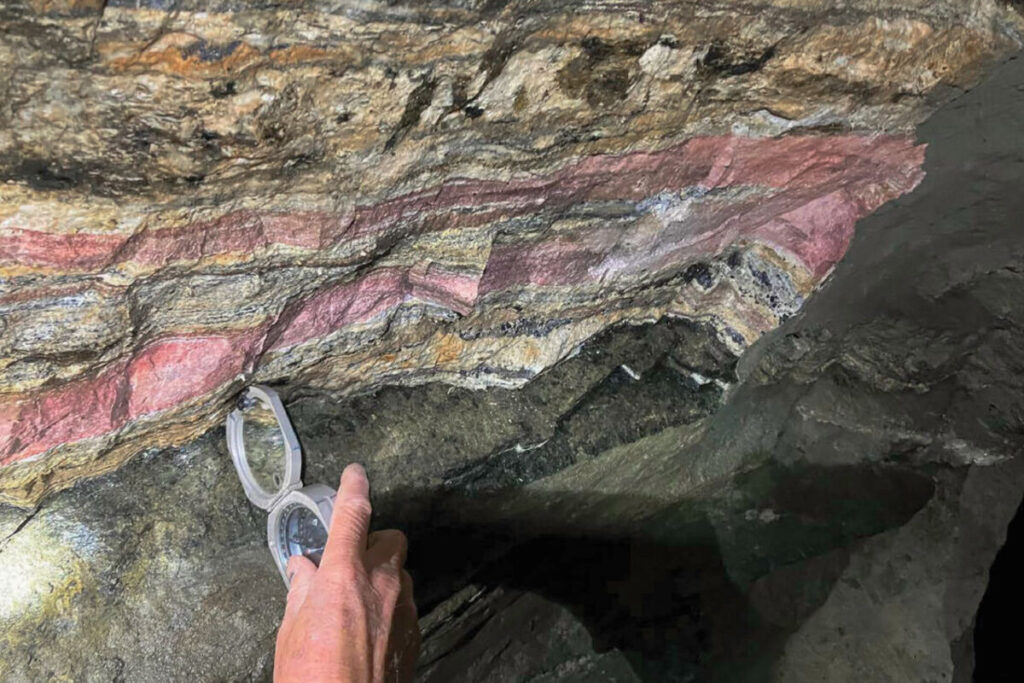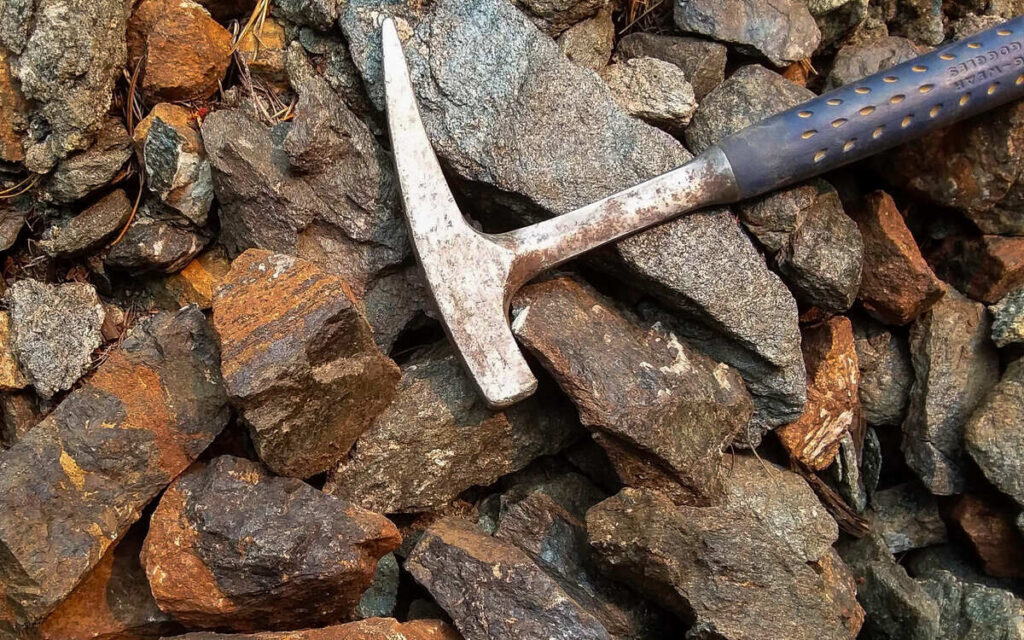
Sheep Creek, Montana Critical Minerals Deposit
February 2025
The finest example of an essential critical minerals deposit in the United States is the US Critical Materials minerals property at Sheep Creek, Montana. A deposit of high-grade rare earths and gallium located in southwest Montana continues to be developed using state-of- the-art processing techniques.
Under a Cooperative Research and Development Agreement (CRADA), the U.S. Government’s Idaho National Laboratory has developed an environmentally responsible separation process for the Sheep Creek rare earths and gallium. US Critical Materials plans to license this cutting- edge processing technology to other deposits in the United States and friendly countries, giving the U.S. a strong “bargaining chip” in its desire to work with overseas critical minerals deposits.
Idaho National Laboratory (INL) is a U.S. Department of Energy (DOE) National Laboratory engaged in world-leading critical materials research and development. INL excels in technology development in the Advanced Separation Science & Engineering technology space and is known throughout the DOE system as the Separation Sciences Testbed.
Funded by US Critical Materials, the separation process will be used on Sheep Creek’s 62 carbonatites covering 800 acres under mining claims on U.S. Forest Service lands. Averaging
9.1 percent rare-earth oxide, and 300 ppm gallium, the deposit may be one of the richest in North America. Geophysical and Artificial Intelligence data suggest that there may be a continuous source of ore at depth.
The United States imports most of its rare earths from China. China also has a near worldwide monopoly on the processing of rare earths. The U.S. Department of Defense (DoD) uses rare earth elements for a variety of purposes in its weapon systems – in radar, guidance systems, precision-guided munitions, lasers, satellites, and equipment including night vision goggles, yet mostly depends on China for its supply.
According to the DoD “Continued U.S. reliance on foreign sources for rare earth products poses a risk to national security. The U.S. and most of the world depends on China for many rare earth elements.” [1]
Rare Earths are also essential for the production of a full range of industrial and consumer goods including batteries, mobile phones, laptops, hard drives, lasers, electric vehicles, semiconductors, computer chips, 5g technology, solar panels, wind turbines and medical diagnostic devices.
China had the foresight many years ago to capitalize on its rare earths’ dominance. In 1987, then-Chinese President Deng Xiaoping famously said, “The Middle East has oil, China has rare earths.” [2]
China has recently begun to weaponize its control of rare earths and rare earths processing, and in the past year has limited the export of gallium, germanium, and antimony, to the United States.
US Critical Materials provides a high grade, reliable domestic source, with the ability to economically extract, separate and process within the United States, and to also export its superior processing technology.
Gallium, scandium, strontium, and rare earths from Sheep Creek are sufficient to meet the needs of the industries in the United States and other friendly countries. Work under the Joint CRADA will allow environmentally responsible processing technology developed at Idaho National Laboratory to economically produce gallium, rare earths, and other critical minerals.
US Critical Materials is a private Nevada corporation, with corporate headquarters in Salt Lake City, Utah. The company has been self-financed and is now considering various funding opportunities.
The US Critical Materials deposit in Montana has sufficient rare earths and gallium to provide the world with the critical elements it needs to help meet demand well into the future.
“The Middle East has oil, Montana has rare earths.”
By James B. Hedrick, former rare-earths commodity specialist at the U.S.G.S., and U.S. Bureau of Mines from 1979 to 2010. President-US Critical Materials Corp. 2021-Present.
REFERENCES
Rare Earths and Critical Minerals: A National Security Imperative
Rare earths and critical minerals are indispensable to U.S. consumer, industrial, and government technologies. These materials serve as the foundation for emerging and future technologies, playing a vital role in manufacturing, clean energy production, semiconductor fabrication, and the defense and aerospace industries.
The United States Geological Survey (USGS) consistently ranks critical minerals among the top supply risks impacting national security and defense. The absence of a domestic rare earth mining and processing capability poses a direct threat to U.S. national security. Rare earth elements (REEs) are essential for semiconductors, 5G technology, smartphones, satellite systems, fiber-optic networks, medical diagnostics, and healthcare therapeutics. They are also critical components in next- generation defense systems, including lasers, radar, sonar, night vision, missile guidance systems, jet engines, and armored vehicle alloys.
Some analysts have dubbed rare earths “the new oil” due to their indispensable role in powering modern and future technologies. With the increasing demand for semiconductors driven by advancements in artificial intelligence (AI) and 5G telecommunications, the global necessity for rare earths is projected to grow exponentially.
U.S. Dependence on Imported Rare Earths
The U.S. remains heavily dependent on imports for rare earth elements and lacks an emergency stockpile for many critical minerals. According to the Congressional Research Service, The National Defense Stockpile (NDS) has a $13.5 billion gap between the current stockpile minerals and current stockpile requirements. This lack of preparedness places the U.S. at significant national security risk, especially as China dominates the global production and processing of rare earths.
China’s near monopoly on rare earths grants it the ability to influence global markets and make decisions with far-reaching national security and economic implications. In December 2024, China imposed an embargo on exporting certain critical minerals to the United States, intensifying the ongoing geopolitical tensions. This restriction has highlighted the U.S. military’s reliance on rare earths for critical technologies and weapon systems, further underscoring the urgent need for a domestic supply chain.

Executive Actions to Restore U.S. Mineral Dominance
On January 20, 2025, President Trump signed two Executive Orders aimed at restoring American leadership in rare earth mining and processing. The orders—Unleashing American Energy and National Energy Emergency—prioritize the strengthening of U.S. production capabilities and supply chain security for critical minerals.
- The Unleashing American Energy order focuses on establishing the U.S. as a leading producer and processor of non- fuel materials, including rare earth elements. It seeks to alleviate regulatory burdens, update the USGS critical minerals list, accelerate the identification of unknown deposits, and increase federal funding for critical mineral projects. A key objective is to address and remedy shortfalls in the National Defense Stockpile.
- The National Energy Emergency order declares that inadequate access to critical minerals poses an imminent threat to national security. The directive identifies vulnerabilities in permitting, outdated regulations, and insufficient federal attention. It mandates actionable recommendations to mitigate these risks and bolster domestic supply chains.

Rare Earths and AI: The Stargate Project
Sheep Creek: A Solution to U.S. Rare Earth Dependence
U.S. Critical Materials’ Sheep Creek deposit in Montana represents the highest-grade rare earth deposit in the United States, with average concentrations of 90,000 parts per million (ppm). The company is collaborating with the Idaho National Laboratory to develop environmentally responsible processing and separation methods, positioning Sheep Creek as a cornerstone of U.S. rare earth independence.
Unlike most rare earth sources globally, where extraction is complex due to mixed ore compositions, Sheep Creek’s deposits offer a more straightforward and efficient processing pathway. This makes it a uniquely valuable domestic resource, capable of reducing U.S. reliance on imports while bolstering national security.
Global Competition for Critical Minerals
The Trump administration’s interest in Greenland has drawn significant attention, given its strategic importance as a source of critical minerals. However, based on reports from the Geological Survey of Denmark and Greenland, Greenland’s rare earth grades average just 1.5% (15,000 ppm), far below the 9% (90,000 ppm) concentration found at Sheep Creek. Additionally, Greenland faces considerable permitting, access, and political challenges, making Sheep Creek a far more viable and strategically advantageous option.
Conclusion
Rare earths and critical minerals are the backbone of modern and emerging technologies, making their secure and reliable supply a matter of national urgency. The development of Sheep Creek’s rare earth resources offers a unique opportunity to address U.S. vulnerabilities, strengthen supply chains, and ensure the country’s continued leadership in critical industries. By investing in domestic production and processing, the U.S. can mitigate supply risks, safeguard national security, and drive economic growth.


Gallium: A Strategic Mineral for U.S. Technology and National Security
Gallium plays a crucial role in a broad array of U.S. consumer, industrial, and government technologies. The United States Geological Survey (USGS) has consistently identified gallium as a critical mineral supply risk, emphasizing its significance for national security and defense.
Demand for gallium is particularly acute in the production of gallium nitride (GaN) and gallium arsenide (GaAs) high-performance chips, which are foundational to semiconductors, 5G technology, smartphones, satellite systems, medical diagnostics and therapeutics, and next-generation defense platforms. As advancements in artificial intelligence (AI) and telecommunications drive a surge in semiconductor demand, the need for gallium is projected to grow substantially.
Despite its criticality, the United States remains entirely dependent on imported gallium, with no emergency reserves in the Department of Defense (DOD) National Defense Stockpile. Gallium is a scarce resource, with most global production concentrated in China. A November 2024 USGS report estimated that a total cessation of China’s gallium exports could result in a $3.1 billion dollar reduction in U.S. GDP, underscoring the vulnerability of supply chains. This concern materialized in December 2024 when the Chinese government implemented an embargo on gallium exports to the United States, heightening tensions over access to critical minerals.
On January 20, 2025, the first day of President Trump’s new administration, the White House declared a National Energy Emergency, highlighting the severe risks associated with restricted access to critical minerals. Gallium is consistently ranked among the most strategically important minerals.
The following day, President Trump announced The Stargate Project, a $500 billion AI initiative, underscoring gallium’s indispensable role in advancing AI technologies.
U.S. Critical Materials’ Sheep Creek deposit in Montana offers the only economically viable domestic source of gallium, with an average grade of 300 parts per million (ppm)—far exceeding the 50 ppm typically found in Chinese production.
This unique deposit positions the United States to establish an independent and secure gallium supply chain. To this end, US Critical Materials is collaborating with the Idaho National Laboratory to develop environmentally sustainable methods for processing and separating gallium. Unlike most global sources, where gallium is a byproduct of bauxite processing, Sheep Creek’s gallium is contained within rare earth minerals, simplifying extraction and refining processes.The Trump administration has also focused on Greenland, a region of significant global competition involving China and Russia, due to its reserves of rare earth elements and critical minerals. However, based on reports from Geological Survey of Denmark and Greenland, Greenland’s gallium concentrations, which range from 66 ppm in North Greenland to 81–117 ppm in Southern East Greenland, are significantly lower than those at Sheep Creek, further highlighting the strategic value of the Montana deposit.
In conclusion, US Critical Materials’ Sheep Creek project represents the nation’s only viable domestic gallium initiative, providing a pivotal opportunity to secure and stabilize the U.S. supply of this essential mineral. Developing Sheep Creek’s gallium resources will not only bolster national security but also support the continued growth of key technologies vital to America’s economic and strategic interests.

